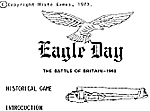
Histo Games (1973)
Designer not credited (believed to be Laurence J. Rusiecki)
Players 2
Period World War II, Battle of Britain Scale
Operational Turn 10 minutes Map not stated (estimated at 5 miles)
Unit Gruppe (27 planes) or Squadron (12 planes)
Components:
Box large ziplock bag
1 22x28" unmounted mapsheet
1 4 page rules folder
1 82 die-cut counters
10 mission sheets
1 errata sheet
Counter Manifest:
112 metallic green German
70 matte brown British
Histo Games says
“The game places you in command of the forces which took part in the original campaign ... Eagle Day is two games-in-one. The Historical Game allows you to re-fight the original battle. The September Game allows you to see what would have happened if the Germans had continued to bomb the RAF’s airfields instead of switching the focus of their attacks to London ... Eagle Day is played in ‘full turns’, each representing ten minutes of time. Each week has 20 full turns ... When the third week is over, the game is ended.”
The reviewer says
“The game was never reviewed in the hobby press ... although it did receive a fairly decent rating in the old S&T rating system (5.96 with 5% played). It has long since dropped out of sight.” Chris Perleberg with J.D. Webster in F&M 72.
Comments
Eagle Day was clearly inspired by Zocchi’s Battle of Britain game (and perhaps by Luftwaffe as well). A side-by-side comparison of the rule books and CRTs reveal some telling similarities. Eagle Day modifies the Battle of Britain system by using a smaller scale map (focusing on the southeast tip of Britain) and by reducing the amount of record keeping required (instead of using logs to track individual aircraft losses, Eagle Day uses units with fixed strengths).
The designer’s attempt to simplify the Battle of Britain system by eliminating the record keeping without other major changes seems ill conceived. Combat becomes an all or nothing affair in which entire squadrons live or die by a single die roll. In addition, the fuel tracking system results in a historical anomaly. Since all aircraft of the same type use a single fuel marker to track endurance, the rules advise: “[T]o keep bookkeeping to a minimum, it is advisable to launch and land all the aircraft of a particular type on the same turns” (somewhat reminiscent of the infamous drop-tank rule in Luftwaffe).
Unfortunately, what could have been an interesting new game based on a proven system instead appears to be a cheap retread. As the Battle of Britain profile in Simulacrum 5 implies, Eagle Day gets my vote for the worst wargame based on the campaign.
Collector’s Notes
This game turns up for sale online fairly infrequently, often accompanied by puffery as to how hard it is to find. The prices, on the other hand, seem to reflect how lackluster a game it is in spite of its rarity. Boone lists low/ high/average prices of 9/24/15.00 at auction and 14/60/31.00 for sale. Eagle Day was later sold through Excalibre Games, reportedly with identical components.
Although my second-hand copy of Eagle Day came in an 11”x14” SPI-style flat tray, I have been unable to confirm that this was the original packaging. According to Art Kritzer, both the Histo and Excalibre versions were sold in a large ziplock. An examination of the counter sheet in my copy leads me to believe that the British counters are unusually susceptible to wear, so make sure to inquire carefully if you are buying a copy sight unseen.
Also from Histo Games
1944; and Hannibal, The Italian Campaign.
-
Introduction
Eagle Day Battle of Britain 1940
Eastern Front Tank Leader World War II
Eighth Air Force: Air War Over Europe, 1942-45
Escape From Altassar Sci-Fi POW
Europe Aflame World War II
Back to Simulacrum Vol. 2 No. 4 Table of Contents
Back to Simulacrum List of Issues
Back to MagWeb Master Magazine List
© Copyright 2000 by Steambubble Graphics
This article appears in MagWeb (Magazine Web) on the Internet World Wide Web. Other military history articles and gaming articles are available at http://www.magweb.com